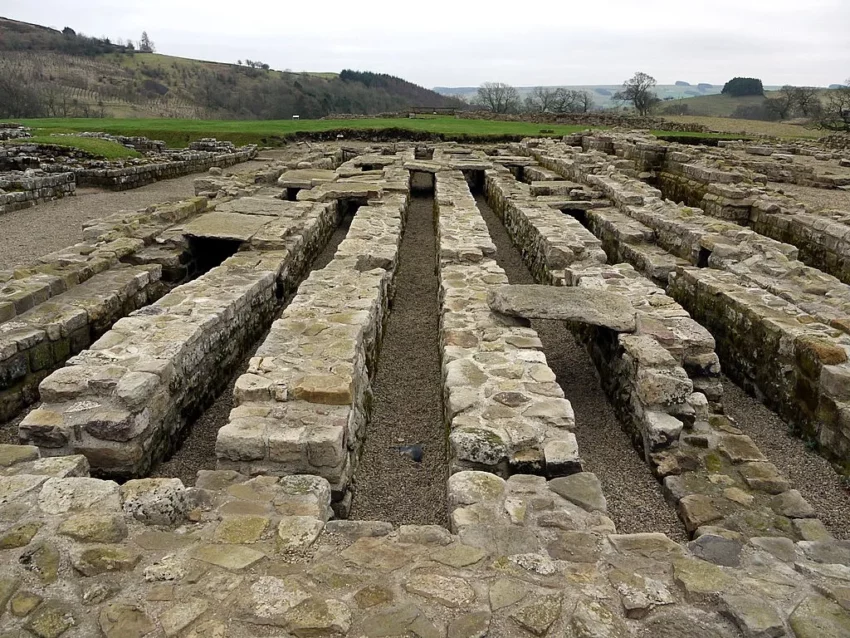Vindolanda is a fascinating historical site located near Hadrian’s Wall in Northern England. It was a Roman auxiliary fort (castrum) and village (vicus) that served as a military post on the northern frontier of Britannia. The site is renowned for the Vindolanda tablets, one of the most important finds of military and personal correspondence (written on wooden tablets) from the Roman world. These artifacts provide invaluable insights into the daily lives of the soldiers, families, and civilians who lived there nearly 2,000 years ago. Vindolanda remains a rich source of archaeological discovery, with ongoing excavations revealing more about the Roman Empire’s reach into ancient Britain.
Get your dose of History via Email
Historical Background of Vindolanda
The discovery of Vindolanda dates back to 1702, but it was not until the 20th century that significant excavations began. Eric Birley, an archaeologist, initiated systematic research in 1930. The site’s strategic importance was due to its location near Hadrian’s Wall, built by Emperor Hadrian in 122 AD to protect the Roman province from northern tribes. The fort predates the wall, suggesting its establishment was around 85 AD. The builders were the Roman army, which staffed the fort with auxiliary units.
Over time, Vindolanda was garrisoned by various troops, including the First Cohort of Tungrians and the Fourth Cohort of Gauls. These units left behind a wealth of artifacts and written records. The fort underwent several reconstructions, reflecting changes in military strategy and the needs of its inhabitants. The site also evolved to include a civilian settlement, providing services to the fort.
One of the most historically significant aspects of Vindolanda is the Vindolanda tablets. Discovered in 1973 by Robin Birley, Eric’s son, these documents have shed light on the social, economic, and military aspects of frontier life. The tablets are notable for containing personal messages, official military reports, and even invitations to birthday parties.
After the Roman withdrawal from Britain in the 5th century, Vindolanda fell into disuse. However, it was not completely abandoned. The site shows evidence of continued occupation, including the presence of a Christian church, suggesting that local communities made use of the fort’s remains. The site’s significance continued to be recognized throughout history, with references to it in medieval documents.
Vindolanda has also been the scene of historical importance beyond the Roman occupation. Archaeological evidence points to activity during the post-Roman period, and the site has been a focal point for understanding the transition from Roman Britain to the early medieval period. The ongoing excavations at Vindolanda continue to contribute to our understanding of this historical transition.
About Vindolanda
Vindolanda was more than just a military outpost; it was a thriving community. The fort itself was constructed primarily of stone and timber, with the earliest phases being predominantly timber. Over the centuries, the fort was rebuilt several times, each reconstruction reflecting advancements in Roman military architecture.
The fort’s layout typically included barracks for the soldiers, a commandant’s house, granaries, and workshops. The surrounding village, or vicus, housed the families of the soldiers, traders, and other civilians. The vicus included houses, shops, taverns, and temples, all essential for the community’s daily life.
Architectural highlights of Vindolanda include the remains of the commanding officer’s house, which was more elaborate than the other buildings, with evidence of central heating systems known as hypocausts. The site also had strong defensive features, such as ramparts and ditches, which were crucial for the security of the frontier.
The building materials used at Vindolanda varied over time. Initially, the fort was constructed using local timber, but later phases saw the introduction of stone buildings. The stone was likely sourced from nearby quarries, a common practice for Roman forts in the region.
Excavations have uncovered numerous artifacts, including pottery, textiles, leather goods, and personal items like combs and jewelry. These finds provide a glimpse into the material culture of the inhabitants and their connections to the wider Roman world. The Vindolanda tablets, in particular, are a testament to the literacy and administrative sophistication of the Roman military.
Theories and Interpretations
The purpose of Vindolanda has been the subject of much scholarly debate. While its primary function was military, the presence of a large civilian settlement suggests it also played a significant role in trade and commerce. Theories about the site’s use include it being a customs post, a policing station for the nearby Stanegate road, and a base for controlling the local population.
The Vindolanda tablets have sparked numerous interpretations about life on the Roman frontier. Some scholars suggest that the fort’s inhabitants experienced a cosmopolitan lifestyle, interacting with people from across the empire. Others point to the harsh conditions and isolation implied by the correspondence.
Mysteries still abound at Vindolanda, particularly regarding the extent of the settlement and the lives of non-military residents. Archaeologists continue to piece together evidence to understand the social hierarchy and the interactions between the fort’s inhabitants and the local tribes.
Dating the various phases of Vindolanda has been achieved through a combination of methods, including dendrochronology (tree-ring dating) and radiocarbon dating. These techniques have helped establish a timeline for the construction and occupation of the site.
Interpretations of Vindolanda are also informed by comparisons with other Roman sites in Britain and the rest of the empire. By matching findings at Vindolanda with historical records, archaeologists have been able to create a more complete picture of Roman military and civilian life in this remote frontier region.
At a glance
Country: United Kingdom
Civilization: Roman Empire
Age: Established around 85 AD
Conclusion and Sources
Reputable sources used in the creation of this article include:

